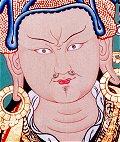 |
||||
 |
 |
 |
||
 |
THE MASTER SPREADS THE DHARMA IN THE LAND OF SNOWS
Being born from Avalokiteshvara’s tears, she naturally had great faith in the Dharma and thus commissioned the construction of a magnificent stupa in Boudha near Kathmandu in Nepal. However she died before the stupa was completed. Her four sons vowed to complete the unfinished stupa, and in honour of their mother, and out of supreme faith in the Dharma, they made solemn prayers from the bottoms of their hearts. Upon completion of the stupa, they each fervently prayed to be reborn as a Dharma king, a great learned khenpo, a powerful tantric master, and a messenger that would bring the previous three together. Legend also has it that during the construction of the stupa a wise donkey was commissioned and overheard the four sons’ prayers. Hearing this, the donkey thought, "I have done so much work for them and they don’t even remember me in their prayers! I vow to do my best to destroy the fruits of their prayers." According to their aspirations, one son was reborn as Trisong Deutsen, the 38th king of Tibet and an incarnation of Manjushri. One son was reborn as the kings’ messenger who invited both the great Khenpo Shantarakshita and the tantric master Guru Padmasambhava from India, who were the reincarnations of the other two sons. Guru Padmasambhava, recalling his past aspirations, accepted the invitation, and on his way he subdued all the harmful gods and demons of Tibet, making them faithful guardians of the Dharma. After meeting in Tibet, the king, guru and khenpo together constructed Tibet’s first great monastery at Samye and fully furnished it with statues. In addition they gave monk’s vows tot Tibet’s first seven monks, standardised translation methods, supervised translation of most of the sutras and tantras from Sanskrit to Tibetan, and for the first time in Tibet, firmly established the tradition of study, contemplation and meditation, thereby radiating the Buddha Dharma in Tibet like rays of the sun. As for the donkey, he was later reborn as Langdharma, the 41st king of Tibet, and subsequently almost succeeded in eliminating the Dharma from Tibet. Not leaving even the space of a horse-hoof untouched, Guru Padmasambhava miraculously walked upon the entire land of Tibet and generally blessed all the mountains, lakes and caves as places for accomplishment. Specifically in the Ngari region of upper Tibet he blessed twenty mountain caves. In Utsang he blessed twenty-one sacred places of accomplishment. In Dokham he blessed twenty-five sacred places, as well as the three kingly treasure places in upper, central and lower Tibet, the five provinces, three valleys, one island and so forth. In addition, for the sake of beings to be tamed in the future, Guru Padmasambhava concealed eighteen varieties of treasure which include treasure texts, material wealth, holy images and so forth, and gave explicit prophesies regarding the future manifestation of these treasures, including the revealer and protector of the treasure, as well as the time of revelation. So forth were the enlightened activities performed for the sake of sentient beings by Guru Padmasambhava’s eight manifestations which are as follows: Padmavajra, Vajra of the Lotus, severed the roots of the five poison. Padmaraja, King of the Lotus, provided mundane and ultimate benefits to sentient beings. Padmasambhava, the Lotus-born, blessed beings endowed with faith. Dorje Droled tamed the Yakshas and haughty beings. Suryaprabha, the Rays of the Sun, taught the essence of secret mantra. Sakyasimha, the Lion of Sakyas, guided beings towards the path of liberation. Simhanada, Roar of the Lion, defeated the outside aggressors of non-Buddhists. And Dhimanvaruchi, the Supremely Wise Love, showered the teaching of sutra and mantra. The results of Guru Padmasambhava’s activities include the attainment of liberation by his twenty-five disciples and eighty other disciples who attained rainbow body. In addition, three million disciples achieved stability in tantric generation stage practice, one hundred thousand disciples showed signs of accomplishment, ninety thousand disciples achieved the uncontaminated Illusory Body, and eighty million disciples had some attainment. Having accomplished these great activities, knowing his personal beings to be tamed on Earth were exhausted, he departed for the South-western universe of the magical cannibals, to help the beings there and to protect Earth from their harm. Guru
Padmasambhava is said to have lived for three thousand and six hundred
years in India upholding the Buddha’s teachings and benefiting
sentient beings. But for his stay in Tibet there are many unreliable
versions claiming he stayed for three years, six years, thirteen years
and so forth. Despite these differences, according to Guru Padmasambhava’s
own kama teachings, he actually stayed for fifty years and three months,
directly manifesting the meaning of the teachings by benefiting countless
sentient beings in incredible myriad ways according to their desires
and propensities, which is a reliable and trustworthy fact. Annapurna
- Muktinath
Map - Muktinath
History -
Muktinath Lama Wangyal From
"Oasis of Liberation" |
|
 |
|
 When
Lord Buddha gave Avalokiteshvara the responsibility of taming the
backwards land of Tibet, Avalokiteshvara looked at the barbaric land
and shed tears of compassion. From these tears the Goddess Ganga and
Gangchungma were born. One day Goddess Gangchungma stole some celestial
flowers and due to her decline in merit, when she died she was unable
to again take rebirth as a god and fell to the human realm. She took
birth as the human woman, Dechogma, the daughter of Sale from the
Jardzinma caste.
When
Lord Buddha gave Avalokiteshvara the responsibility of taming the
backwards land of Tibet, Avalokiteshvara looked at the barbaric land
and shed tears of compassion. From these tears the Goddess Ganga and
Gangchungma were born. One day Goddess Gangchungma stole some celestial
flowers and due to her decline in merit, when she died she was unable
to again take rebirth as a god and fell to the human realm. She took
birth as the human woman, Dechogma, the daughter of Sale from the
Jardzinma caste.